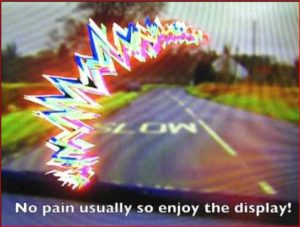Scintillating Scotoma
What Is Scintillating Scotoma?
Scotoma is a blind spot in your field of vision. Scintillating scotoma is one of the forms of scotoma. It refers to the confined areas of blindness within your field of vision that appears before the start of migraine.

Types
Other types of scotoma include:
Paracentral scotoma
It causes loss of vision in regions close to the central vision.
Peripheral scotoma
It affects vision towards the edge of the vision field.
Hemianopic scotoma
It reduces vision in half of the area within your central vision.
Central scotoma
It affects vision within the field of vision.
In scintillating scotoma, a small spot of flickering light appears in your field of vision especially at the peripheral.
This spot grows slowly in size and may form arcs of light or zig-zag patterns. Within this arc, there is reduced vision. While beyond the arc edge, your vision is normal.
Scintillating scotoma is also associated with aura migraines. Aura occurs when you are disturbed with visual things such as flickering light.
In some cases, aura can also happen as touching, movement or oral disturbances. In this case, you feel as if you are touched.
Causes
Although the exact causes of scintillating scotoma are unknown, migraine triggers can also cause this condition. The following are risk factors for migraine that may promote scintillating scotoma2:
Changes in female hormones
In most females, changes in estrogen hormones can cause headaches. In some women with migraine history, headaches can occur before or during menstrual periods after a large drop in estrogen hormone level.
Other women can develop migraines during pregnancy and menopause. Using medicines to boost your hormones can aggravate migraines for those who already have them.
Food
Foods that have high tyramine levels can promote migraines. These foods include processed such as meat, aged like cheese and overripe fruits.
Environmental changes
Variations in weather can also trigger migraine in some people. Change of weather form hot to cold or vice versa can make people develop migraines.
Alcohol
Alcohol especially wine and other beverages that contain coffee can also trigger migraines in people who use them.
Addictives
Foods that contain addictives or preservatives such as Mono sodium glutamate can promote migraines.
Stress
People who lead a stressful life are at danger of developing migraines.
Sleeping partner
Sleep partners can also cause migraines in people. Those people who miss sleep or sleep too much are more likely to develop migraine.
Other causes of scintillating scotoma include:
Multiple sclerosis
This is a severe disease that occurs in your nervous system. Although the cause of multiple sclerosis is unknown, it is associated with autoimmune diseases.
Autoimmune diseases occur when an immune system attacks and destroys healthy tissues in your body. For multiple sclerosis, the hyperactive immune system destroys the myelin sheath which protects the nerve fibers.
This exposes the nerve fibers to any form of destruction. As a result, your nerves are damaged which disrupts communication around your body.
Multiple sclerosis can cause scintillating scotoma as it interferes with vision. It can cause total or partial blindness in your eyes. This reduced vision can continue for a long time in people with multiple sclerosis.
Risk factors for Multiple sclerosis
The following factors increase your risk of developing multiple sclerosis.
Other infections
People with viral infections such as infectious mononucleosis caused by Epstein-Barr can also develop this disease.
Autoimmune diseases
People suffering from other autoimmune diseases such as type 1 diabetes, thyroid diseases or inflammatory bowel disease are at higher risk of developing multiple sclerosis.
Age and gender
This disease can happen at all ages, but it affects people as early as age 15-60 years. Women are more likely to develop multiple sclerosis than men.
Family history of multiple sclerosis
If this disease runs in the family, you are likely to develop it.
Optic Neuritis
Optic nerves are vital in your body because they help transmit visual information between your eyes to the brain.
When the optic nerve becomes inflamed, this condition is known as optic Neuritis. This affects transmission of information from your eyes to the brain. This inflammation can be due to a nerve disease or infection. This causes a brief reduced vision in one of your eyes. You can also experience pain in the affected eye. The real cause of optic Neuritis is still unknown; however it is linked to multiple sclerosis. Infact, the first sign and symptom of this disease is multiple sclerosis. It occurs when your immune system destroys myelin sheath in your brain. This hinders transmission of visual information from the eyes to the brain.
Other diseases that can damage your nerves include Schilder’s disease and neuromyelitis optica.
Optic Neuritis can also be caused by infections. They include:
- Viral encephalitis
- Sinusitis
- Lyme disease
Optic neuritis can cause blindness in one of your eyes; it can be mild or severe and take about 10 days. It can also make you to see flash lights at the sides of one or both of your eyes. You can also experience pain around your eyes as well as having difficult to recognize colors.
Symptoms
The signs and symptoms of appear gradually and may last for one hour and thirty minutes or less. It starts as small spots of flickering light and increases in size to form zigzag pattern of light.
It can then proceed in to headache with aura or resolve on its own if a person has no headache. Some people with scintillating scotoma complain of fatigue, nausea and feeling dizzy.

Diagnosis
Your doctor can use visual field test to detect problems with your vision. Visual field test is used to help your doctor find out your ability to view objects on all sides and as well as central vision.
Other tests are required to exclude other similar eye problems and confirm the diagnosis of scintillating scotoma.
Treatment
There is no known cure of scintillating scotoma. However, treatment focuses on treating the underlying cause of this disease.
In addition, you can minimize eye problems by going for regular eye screening to detect and correct those problems at an early stage. You can also increase intake of vitamin C foods to improve your vision such as citrus fruits, pepper, tropical fruits, etc.
Reference List
- Scotoma (blind spot). Available at http://www.primehealthchannel.com/scotoma-blind-spot.html
- Scintillating scotoma. Available at http://www.huntlycentre.com.au/updates/posts/view/169
- Optic Neuritis. Available at http://www.healthline.com/health/optic-neuritis#overview1
- Scotoma. Available at http://www.britannica.com/EBchecked/topic/529529/scotoma
